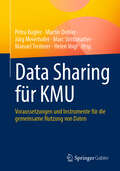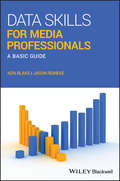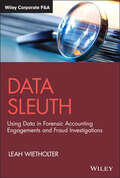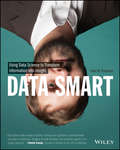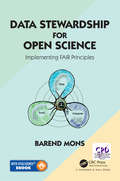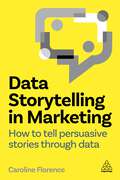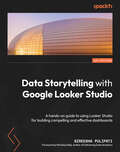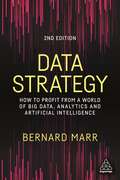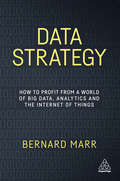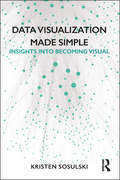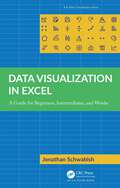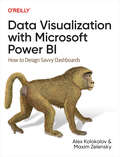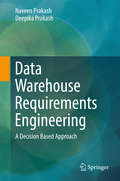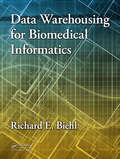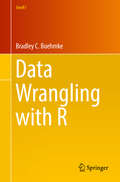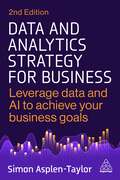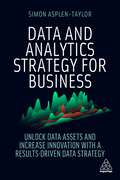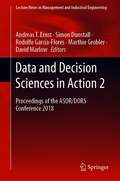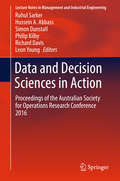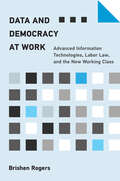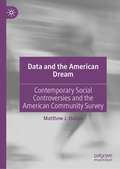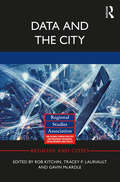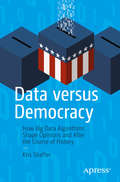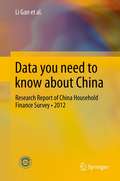- Table View
- List View
Data Sharing für KMU: Voraussetzungen und Instrumente für die gemeinsame Nutzung von Daten
by Jürg Meierhofer Petra Kugler Martin Dobler Marc Strittmatter Manuel Treiterer Helen VogtEin bewusster Umgang mit Daten ist für Unternehmen wichtiger denn je: Sie fördern Innovation in Geschäftsmodellen, erfordern aber auch einen effizienten und nachhaltigen Datenumgang. Unternehmen, die Daten teilen und nutzen, wirtschaften effizienter durch Data Sharing. In diesem Fachbuch werden verschiedene Aspekte des Data Sharings aus unternehmensübergreifender und -interner Perspektive, vorwiegend mit Blick auf kleine und mittelständische Unternehmen (KMU), betrachtet. Die Autor:innen untersuchen, wie Unternehmen Anreize schaffen können, um erfolgreich an der Datenökonomie teilzunehmen, aber auch welche externen Bedingungen gegeben sein sollten, um Unternehmen in die Lage zu versetzen, ihre ökonomischen Potenziale in Bezug auf Daten zu maximieren.Das Buch zeigt, wie KMU den Wert ihrer Daten optimieren, vertrauensvolle Partnerschaften aufbauen, Sicherheitsbarrieren überwinden, eine datenzentrierte Kultur fördern und rechtliche Fragen auf praktische und effektive Weise regeln können. Die Autor:innen stellen umsetzbare Erkenntnisse und Beispiele aus der Praxis vor und geben KMUs die Werkzeuge an die Hand, um in einem datenzentrierten Geschäftsumfeld erfolgreich zu sein. Der Inhalt Das Data Sharing Framework: Vertrauen, Organisationskultur, Wert von Daten, Sicherheit und Recht & Governance Strategische Dimensionen, Datenbewertung in der Praxis, ESG-Berichterstattung, Monetarisierung, LLM und Datenökosysteme Fallstudien
Data Skills for Media Professionals: A Basic Guide
by Ken Blake Jason ReinekeTeaches the basic, yet all-important, data skills required by today’s media professionals The authors of Data Skills for Media Professionals have assembled a book that teaches key aspects of data analysis, interactive data visualization and online map-making through an introduction to Google Drive, Google Sheets, and Google My Maps, all free, highly intuitive, platform-agnostic tools available to any reader with a computer and a web connection. Delegating the math and design work to these apps leaves readers free to do the kinds of thinking that media professionals do most often: considering what questions to ask, how to ask them, and how to evaluate and communicate the answers. Although focused on Google apps, the book draws upon complementary aspects of the free QGIS geographic information system, the free XLMiner Analysis ToolPak Add-on for Google Sheets, and the ubiquitous Microsoft Excel spreadsheet application. Worked examples rely on frequently updated data from the U.S. Bureau of Labor Statistics, the Federal Election Commission, the National Bridge Inventory of structurally deficient bridges, and other federal sources, giving readers the option of immediately applying what they learn to current data they can localize to any area in the United States. The book offers chapters covering: basic data analysis; data visualization; making online maps; Microsoft Excel and pivot tables; matching records with Excel's VLOOKUP function; basic descriptive and inferential statistics; and other functions, tools and techniques. Serves as an excellent supplemental text for easily adding data skills instruction to courses in beginning or advanced writing and reporting Features computer screen captures that illustrate each step of each procedure Offers downloadable datasets from a companion web page to help students implement the techniques themselves Shows realistic examples that illustrate how to perform each technique and how to use it on the job Data Skills of Media Professionals is an excellent book for students taking skills courses in the more than 100 ACEJMC-accredited journalism and mass communication programs across the United States. It would also greatly benefit those enrolled in advanced or specialized reporting courses, including courses dedicated solely to teaching data skills.
Data Sleuth: Using Data in Forensic Accounting Engagements and Fraud Investigations (Wiley Corporate F&A)
by Leah WietholterStraightforward, practical guidance for working fraud examiners and forensic accountants In Data Sleuth: Using Data in Forensic Accounting Engagements and Fraud Investigations, certified fraud examiner, former FBI support employee, private investigator, and certified public accountant Leah Wietholter delivers a step-by-step guide to financial investigation that can be applied to almost any forensic accounting use-case. The book emphasizes the use of best evidence as you work through problem-solving data analysis techniques that address the common challenge of imperfect and incomplete information. The accomplished author bridges the gap between modern fraud investigation theory and practical applications and processes necessary for working practitioners. She also provides: Access to a complimentary website with supplementary resources, including a Fraud Detection Worksheet and case planning template Strategies for systematically applying the Data Sleuth® framework to streamline and grow your practice Methods and techniques to improve the quality of your work productData Sleuth is an indispensable, hands-on resource for practicing and aspiring fraud examiners and investigators, accountants, and auditors. It’s a one-of-a-kind book that puts a practical blueprint to effective financial investigation in the palm of your hand.
Data Smart
by John W. ForemanData Science gets thrown around in the press like it's magic. Major retailers are predicting everything from when their customers are pregnant to when they want a new pair of Chuck Taylors. It's a brave new world where seemingly meaningless data can be transformed into valuable insight to drive smart business decisions.But how does one exactly do data science? Do you have to hire one of these priests of the dark arts, the "data scientist," to extract this gold from your data? Nope.Data science is little more than using straight-forward steps to process raw data into actionable insight. And in Data Smart, author and data scientist John Foreman will show you how that's done within the familiar environment of a spreadsheet. Why a spreadsheet? It's comfortable! You get to look at the data every step of the way, building confidence as you learn the tricks of the trade. Plus, spreadsheets are a vendor-neutral place to learn data science without the hype. But don't let the Excel sheets fool you. This is a book for those serious about learning the analytic techniques, the math and the magic, behind big data. Each chapter will cover a different technique in a spreadsheet so you can follow along:Mathematical optimization, including non-linear programming and genetic algorithmsClustering via k-means, spherical k-means, and graph modularityData mining in graphs, such as outlier detectionSupervised AI through logistic regression, ensemble models, and bag-of-words modelsForecasting, seasonal adjustments, and prediction intervals through monte carlo simulationMoving from spreadsheets into the R programming languageYou get your hands dirty as you work alongside John through each technique. But never fear, the topics are readily applicable and the author laces humor throughout. You'll even learn what a dead squirrel has to do with optimization modeling, which you no doubt are dying to know.
Data Stewardship for Open Science: Implementing FAIR Principles
by Barend MonsData Stewardship for Open Science: Implementing FAIR Principles has been written with the intention of making scientists, funders, and innovators in all disciplines and stages of their professional activities broadly aware of the need, complexity, and challenges associated with open science, modern science communication, and data stewardship. The FAIR principles are used as a guide throughout the text, and this book should leave experimentalists consciously incompetent about data stewardship and motivated to respect data stewards as representatives of a new profession, while possibly motivating others to consider a career in the field. The ebook, avalable for no additional cost when you buy the paperback, will be updated every 6 months on average (providing that significant updates are needed or avaialble). Readers will have the opportunity to contribute material towards these updates, and to develop their own data management plans, via the free Data Stewardship Wizard.
Data Storytelling in Marketing: How to Tell Persuasive Stories Through Data
by Caroline FlorenceMarketers are storytellers, they write content, marketing strategies and devise internal communications, but unless these stories are evidence-based, they won't be believable or truly persuasive. Understanding how to use data to build and tell stories is an increasingly important part of the modern-day marketers' toolkit. Stories centered on robust evidence and credible data can withstand challenges, provide meaning, offer insight and engage audiences.This book is designed to plug the data storytelling skills gap and enable marketing professionals to cut through the data overload, join the data dots and create engaging narratives and content. Regardless of whether you're a data expert, data anxious or a data sceptic, this book will give you the tools to help you to communicate more effectively with your customers and your stakeholders. Written by expert trainer Caroline Florence, this book outlines how to build robust and compelling data stories. Drawing on her client work with companies such as Toyota, Lactalis, News UK, Mars Petcare and AXA, plus contributions from experts across data, insights, marketing and customer experience, this book provides a practical roadmap to increase your influence with data storytelling.
Data Storytelling with Google Looker Studio: A hands-on guide to using Looker Studio for building compelling and effective dashboards
by Nicholas Kelly Sireesha PulipatiApply data storytelling concepts and analytical thinking to create dashboards and reports in Looker Studio to aid data-driven decision makingKey FeaturesGain a solid understanding of data visualization principles and learn to apply them effectivelyGet to grips with the concepts and features of Looker Studio to create powerful data storiesExplore the end-to-end process of building dashboards with the help of practical examplesBook DescriptionPresenting data visually makes it easier for organizations and individuals to interpret and analyze information. Looker Studio is an easy-to-use, collaborative tool that enables you to transform your data into engaging visualizations. This allows you to build and share dashboards that help monitor key performance indicators, identify patterns, and generate insights to ultimately drive decisions and actions. Data Storytelling with Looker Studio begins by laying out the foundational design principles and guidelines that are essential to creating accurate, effective, and compelling data visualizations. Next, you'll delve into features and capabilities of Looker Studio – from basic to advanced – and explore their application with examples. The subsequent chapters walk you through building dashboards with a structured three-stage process called the 3D approach using real-world examples that'll help you understand the various design and implementation considerations. This approach involves determining the objectives and needs of the dashboard, designing its key components and layout, and developing each element of the dashboard. By the end of this book, you will have a solid understanding of the storytelling approach and be able to create data stories of your own using Looker Studio.What you will learnUnderstand what storytelling with data means, and explore its various formsDiscover the 3D approach to building dashboards – determine, design, and developTest common data visualization pitfalls and learn how to mitigate themGet up and running with Looker Studio and leverage it to explore and visualize dataExplore the advanced features of Looker Studio with examplesBecome well-versed in the step-by-step process of the 3D approach using practical examplesMeasure and monitor the usage patterns of your Looker Studio reportsWho this book is forIf you are a beginner or an aspiring data analyst looking to understand the core concepts of data visualization and want to use Looker Studio for creating effective dashboards, this book is for you. No specific prior knowledge is needed to understand the concepts present in this book. Experienced data analysts and business intelligence developers will also find this book useful as a detailed guide to using Looker Studio as well as a refresher of core dashboarding concepts.
Data Strategy: How to Profit from a World of Big Data, Analytics and Artificial Intelligence
by Bernard MarrBRONZE RUNNER UP: Axiom Awards 2018 - Business Technology Category (1st edition)Data is an integral strategic asset for all businesses. Learn how to leverage this data and generate valuable insights and true business value with bestselling author and data guru Bernard Marr.Data has massive potential for all businesses when used correctly, from small organizations to tech giants and huge multinationals, but this resource is too often not fully utilized. Data Strategy is the must-read guide on how to create a robust, data-driven approach that will harness the power of data to revolutionize your business. Explaining how to collect, use and manage data, this book prepares any organization with the tools and strategies needed to thrive in the digital economy.Now in its second edition, this bestselling title is fully updated with insights on understanding your customers and markets and how to provide them with intelligent services and products. With case studies and real-world examples throughout, Bernard Marr offers unrivalled expertise on how to gain the competitive advantage in a data-driven world.
Data Strategy: How to Profit from a World of Big Data, Analytics and the Internet of Things
by Bernard MarrData is revolutionizing the way we all do business. Every business is now a data business and needs a robust Data Strategy. However less than 0.5% of all data is ever analysed and used, offering huge potential for organisations when trying to leverage this key strategic asset. What is the value of your data and how does it generate business value? Data Strategy, by bestselling author Bernard Marr, provides a clear blueprint showing what organizations need to do to define and execute an effective plan for one of their biggest strategic assets: data. It shows you how to: - define your strategic data assets and data audience - gather the required data and put in place new collection methods - get the most from predictive analytics and machine learning - have the right technology, data infrastructure and key data competencies - ensure you have an effective security and governance system in place to avoid huge financial, legal and reputational problems. Illustrated with case examples of organizations such as Walmart, RBS, Google and NASA, Data Strategy will equip any organization with the tools and strategies it needs to profit from big data, analytics and the Internet of Things.
Data Visualization Made Simple: Insights into Becoming Visual
by Kristen SosulskiData Visualization Made Simple is a practical guide to the fundamentals, strategies, and real-world cases for data visualization, an essential skill required in today’s information-rich world. With foundations rooted in statistics, psychology, and computer science, data visualization offers practitioners in almost every field a coherent way to share findings from original research, big data, learning analytics, and more. In nine appealing chapters, the book: examines the role of data graphics in decision-making, sharing information, sparking discussions, and inspiring future research; scrutinizes data graphics, deliberates on the messages they convey, and looks at options for design visualization; and includes cases and interviews to provide a contemporary view of how data graphics are used by professionals across industries Both novices and seasoned designers in education, business, and other areas can use this book’s effective, linear process to develop data visualization literacy and promote exploratory, inquiry-based approaches to visualization problems.
Data Visualization in Excel: A Guide for Beginners, Intermediates, and Wonks (AK Peters Visualization Series)
by Jonathan SchwabishThis book closes the gap between what people think Excel can do and what they can achieve in the tool. Over the past few years, recognition of the importance of effectively visualizing data has led to an explosion of data analysis and visualization software tools. But for many people, Microsoft Excel continues to be the workhorse for their data visualization needs, not to mention the only tool that many data workers have access to. Although Excel is not a specialist data visualization platform, it does have strong capabilities. The default chart types do not need to be the limit of the tool’s data visualization capabilities, and users can extend its features by understanding some key elements and strategies. Data Visualization in Excel provides a step-by-step guide to creating more advanced and often more effective data visualizations in Excel and is the perfect guide for anyone who wants to create better, more effective, and more engaging data visualizations.
Data Visualization with Microsoft Power BI: How to Design Savvy Dashboards
by Alex Kolokolov Maxim ZelenskyThe sheer volume of business data has reached an all-time high. Using visualizations to transform this data into useful and understandable information can facilitate better decision-making. This practical book shows data analysts as well as professionals in finance, sales, and marketing how to quickly create visualizations and build savvy dashboards.Alex Kolokolov from Data2Speak and Maxim Zelensky from Intelligent Business explain in simple and clear language how to create brilliant charts with Microsoft Power BI and follow best practices for corporate reporting. No technical background is required. Step-by-step guides help you set up any chart in a few clicks and avoid common mistakes. Also, experienced data analysts will find tips and tricks on how to enrich their reports with advanced visuals.This book helps you understand:The basic rules for classic charts that are used in 90% of business reportsExceptions to general rules based on real business casesBest practices for dashboard designHow to properly set up interactionsHow to prepare data for advanced visualsHow to avoid pitfalls with eye-catching charts
Data Warehouse Requirements Engineering: A Decision Based Approach
by Naveen Prakash Deepika PrakashAs the first to focus on the issue of Data Warehouse Requirements Engineering, this book introduces a model-driven requirements process used to identify requirements granules and incrementally develop data warehouse fragments. In addition, it presents an approach to the pair-wise integration of requirements granules for consolidating multiple data warehouse fragments. The process is systematic and does away with the fuzziness associated with existing techniques. Thus, consolidation is treated as a requirements engineering issue. The notion of a decision occupies a central position in the decision-based approach. On one hand, information relevant to a decision must be elicited from stakeholders; modeled; and transformed into multi-dimensional form. On the other, decisions themselves are to be obtained from decision applications. For the former, the authors introduce a suite of information elicitation techniques specific to data warehousing. This information is subsequently converted into multi-dimensional form. For the latter, not only are decisions obtained from decision applications for managing operational businesses, but also from applications for formulating business policies and for defining rules for enforcing policies, respectively. In this context, the book presents a broad range of models, tools and techniques. For readers from academia, the book identifies the scientific/technological problems it addresses and provides cogent arguments for the proposed solutions; for readers from industry, it presents an approach for ensuring that the product meets its requirements while ensuring low lead times in delivery.
Data Warehousing for Biomedical Informatics
by Richard E. BiehlData Warehousing for Biomedical Informatics is a step-by-step how-to guide for designing and building an enterprise-wide data warehouse across a biomedical or healthcare institution, using a four-iteration lifecycle and standardized design pattern. It enables you to quickly implement a fully-scalable generic data architecture that supports your organization's clinical, operational, administrative, financial, and research data. By following the guidelines in this book, you will be able to successfully progress through the Alpha, Beta, and Gamma versions, plus fully implement your first production release in about a year.
Data Wrangling with R
by Bradley C. BoehmkeThis guide for practicing statisticians, data scientists, and R users and programmers will teach the essentials of preprocessing: data leveraging the R programming language to easily and quickly turn noisy data into usable pieces of information. Data wrangling, which is also commonly referred to as data munging, transformation, manipulation, janitor work, etc., can be a painstakingly laborious process. Roughly 80% of data analysis is spent on cleaning and preparing data; however, being a prerequisite to the rest of the data analysis workflow (visualization, analysis, reporting), it is essential that one become fluent and efficient in data wrangling techniques.This book will guide the user through the data wrangling process via a step-by-step tutorial approach and provide a solid foundation for working with data in R. The author's goal is to teach the user how to easily wrangle data in order to spend more time on understanding the content of the data. By the end of the book, the user will have learned: How to work with different types of data such as numerics, characters, regular expressions, factors, and datesThe difference between different data structures and how to create, add additional components to, and subset each data structureHow to acquire and parse data from locations previously inaccessibleHow to develop functions and use loop control structures to reduce code redundancyHow to use pipe operators to simplify code and make it more readableHow to reshape the layout of data and manipulate, summarize, and join data sets
Data and Analytics Strategy for Business: Leverage Data and AI to Achieve Your Business Goals
by Simon Asplen-TaylorData and AI present a tremendous opportunity to improve business performance by increasing operational efficiency, revenues and customer satisfaction. An effective data strategy leveraging the power of AI allows businesses to create a competitive advantage.Data and Analytics Strategy for Business is a practical guide for business, technology and data leaders building a data, analytics and AI strategy for their organization. Starting by identifying the value you can obtain from data, analytics and AI, this book shows you how to maximise that value to support your organization's goals and mission. It covers the importance of having high quality data to generate trust, getting the whole organization on board as well as all the other essential elements required to complete your strategy. This book provides the keys to using data to drive improved business results.Incorporating the latest developments in AI, this new edition of Data and Analytics Strategy for Business shows how leaders can use AI right away to get value from their existing strategy. It provides practical guidance and recommendations for implementing AI and machine learning to maximize performance. Filled with real-world examples from organizations including Tesco and Facebook, this book is a step-by-step guide to designing and implementing a results-driven data strategy.
Data and Analytics Strategy for Business: Unlock Data Assets and Increase Innovation with a Results-Driven Data Strategy
by Simon Asplen-TaylorFor many organizations data is a by-product, but for the smarter ones it is the heartbeat of their business. Most businesses have a wealth of data buried in their systems which, if used effectively, could increase revenue, reduce costs and risk and improve customer satisfaction and employee experience. Beginning with how to choose projects which reflect your organization's goals and how to make the business case for investing in data, this book then takes the reader through the five 'waves' of organizational data maturity. It takes the reader from getting started on the data journey with some quick wins, to how data can help your business become a leading innovator which systematically outperforms competitors.Data and Analytics Strategy for Business outlines how to build consistent, high-quality sources of data which will create business value and explores how automation, AI and machine learning can improve performance and decision making. Filled with real-world examples and case studies, this book is a stage-by-stage guide to designing and implementing a results-driven data strategy.
Data and Decision Sciences in Action 2: Proceedings of the ASOR/DORS Conference 2018 (Lecture Notes in Management and Industrial Engineering)
by Simon Dunstall Andreas T. Ernst Rodolfo García-Flores Marthie Grobler David MarlowThis book constitutes the proceedings of the Joint 2018 National Conferences of the Australian Society for Operations Research (ASOR) and the Defence Operations Research Symposium (DORS). Offering a fascinating insight into the state of the art in Australian operations research, this book is of great interest to academics and other professional researchers working in operations research and analytics, as well as practitioners addressing strategic planning, operations management, and other data-driven decision-making challenges in the domains of commerce, industry, defence, the environment, humanitarianism, and agriculture. The book comprises 21 papers on topics ranging from methodological advances to case studies, and addresses application domains including supply chains, government services, defence, cybersecurity, healthcare, mining and material processing, agriculture, natural hazards, telecommunications and transportation.ASOR is the premier professional organization for Australian academics and practitioners working in optimization and other disciplines related to operations research. The conference was held in Melbourne, Australia, in December 2018.
Data and Decision Sciences in Action: Proceedings of the Australian Society for Operations Research Conference 2016 (Lecture Notes in Management and Industrial Engineering)
by Richard Davis Hussein A. Abbass Ruhul Sarker Simon Dunstall Philip Kilby Leon YoungOffering a concise and multidisciplinary reference guide to the state of the art in Australian operations research, this book will be of great value to academics working in many disciplines associated with operations research, as well as industrial practitioners engaged in planning, scheduling and logistics. Over 60 papers, with topics ranging from academic research techniques and case studies to industrial and administrative best practices in operations research, address aspects such as: * optimization, combinatorial optimization, decision analysis, supply-chain management, queuing and routing, and project management; and * logistics, government, cyber security, health-care systems, mining and material processing, ergonomics and human factors, space applications, telecommunications and transportation, among many others. This book presents the Proceedings of the National Conference of the Australian Society for Operations Research, the premier professional organization for Australian academics and practitioners working in optimization and other disciplines related to operations research. The conference was held in Canberra in November 2016.
Data and Democracy at Work: Advanced Information Technologies, Labor Law, and the New Working Class
by Brishen RogersAn exploration of how major companies have used advanced information technologies to limit worker power, and how labor law reform could reverse that trend.As our economy has shifted away from industrial production and service industries have become dominant, many of the nation's largest employers are now in fields like retail, food service, logistics, and hospitality. These companies have turned to data-driven surveillance technologies that operate over a vast distance, enabling cheaper oversight of massive numbers of workers. Data and Democracy at Work argues that companies often use new data-driven technologies as a power resource—or even a tool of class domination—and that our labor laws allow them to do so.Employers have established broad rights to use technology to gather data on workers and their performance, to exclude others from accessing that data, and to use that data to refine their managerial strategies. Through these means, companies have suppressed workers' ability to organize and unionize, thereby driving down wages and eroding working conditions.Labor law today encourages employer dominance in many ways—but labor law can also be reformed to become a tool for increased equity. The COVID-19 pandemic and subsequent Great Resignation have indicated an increased political mobilization of the so-called essential workers of the pandemic, many of them service industry workers. This book describes the necessary legal reforms to increase workers' associational power and democratize workplace data, establishing more balanced relationships between workers and employers and ensuring a brighter and more equitable future for us all.
Data and the American Dream: Contemporary Social Controversies and the American Community Survey
by Matthew J. HolianThis book paints a portrait of social life in America by providing an accessible discussion of empirical economics research on issues such as illegal immigration, health care and climate change. All the studies in this book use the same data source: individual responses to the American Community Survey (ACS), the nation's largest household survey.The author identifies studies that clearly illustrate core econometric methods (such as regression control and difference-in-differences), replicates key statistics from the studies, and helps the reader to carefully interpret the statistics. This book has a companion website with replication files in R and Stata format. The Appendix to this book contains a guide to using the free R software, downloading the ACS and other public-use microdata, and running the replication files, which assumes no background knowledge on the part of the reader beyond introductory statistics. By opening up the hood on how top scholars use core econometric methods to analyze large data sets, a motivated reader with a decent computer and Internet connection can use this book to learn not only how to replicate published research, but also to extend the analysis to create new knowledge about important social phenomena. A more casual reader can skip the online supplements and still gain data-driven insights into social and economic behavior. The book concludes by describing how careful empirical estimates can guide decision making, through cost-benefit analysis, to find public policies that lead to greater happiness while accounting for environmental, public health and other impacts.With its accessible discussion, glossary, detailed learning goals, end of chapter review questions and companion resources, this book is ideal for use as a supplementary volume in introductory econometrics or research methods courses.
Data and the City (Regions and Cities)
by Rob Kitchin Tracey P. Lauriault Gavin McArdleThere is a long history of governments, businesses, science and citizens producing and utilizing data in order to monitor, regulate, profit from and make sense of the urban world. Recently, we have entered the age of big data, and now many aspects of everyday urban life are being captured as data and city management is mediated through data-driven technologies. Data and the City is the first edited collection to provide an interdisciplinary analysis of how this new era of urban big data is reshaping how we come to know and govern cities, and the implications of such a transformation. This book looks at the creation of real-time cities and data-driven urbanism and considers the relationships at play. By taking a philosophical, political, practical and technical approach to urban data, the authors analyse the ways in which data is produced and framed within socio-technical systems. They then examine the constellation of existing and emerging urban data technologies. The volume concludes by considering the social and political ramifications of data-driven urbanism, questioning whom it serves and for what ends. This book, the companion volume to 2016’s Code and the City, offers the first critical reflection on the relationship between data, data practices and the city, and how we come to know and understand cities through data. It will be crucial reading for those who wish to understand and conceptualize urban big data, data-driven urbanism and the development of smart cities.
Data versus Democracy: How Big Data Algorithms Shape Opinions and Alter the Course of History
by Kris ShafferHuman attention is in the highest demand it has ever been. The drastic increase in available information has compelled individuals to find a way to sift through the media that is literally at their fingertips. Content recommendation systems have emerged as the technological solution to this social and informational problem, but they’ve also created a bigger crisis in confirming our biases by showing us only, and exactly, what it predicts we want to see. Data versus Democracy investigates and explores how, in the era of social media, human cognition, algorithmic recommendation systems, and human psychology are all working together to reinforce (and exaggerate) human bias. The dangerous confluence of these factors is driving media narratives, influencing opinions, and possibly changing election results. In this book, algorithmic recommendations, clickbait, familiarity bias, propaganda, and other pivotal concepts are analyzed and then expanded upon via fascinating and timely case studies: the 2016 US presidential election, Ferguson, GamerGate, international political movements, and more events that come to affect every one of us. What are the implications of how we engage with information in the digital age? Data versus Democracy explores this topic and an abundance of related crucial questions. We live in a culture vastly different from any that has come before. In a society where engagement is currency, we are the product. Understanding the value of our attention, how organizations operate based on this concept, and how engagement can be used against our best interests is essential in responsibly equipping ourselves against the perils of disinformation.Who This Book Is ForIndividuals who are curious about how social media algorithms work and how they can be manipulated to influence culture. Social media managers, data scientists, data administrators, and educators will find this book particularly relevant to their work.
Data you need to know about China: Research Report of China Household Finance Survey•2012
by Li Gan Zhichao Yin Nan Jia Lu Zheng Shu XuSince the beginning of the 21st century, China has been going through a period of dramatically fast economic development. What is the real life of the Chinese like under China's continued rapid GDP growth? How rich are the rich and how poor are the poor? This book provides first-hand data on Chinese households' living standards, which may answer the above questions to some extent. The Survey and Research Center for China Household Finance conducted the first and only nationally representative survey on household finance in China in 2011. Based on the results from the China Household Finance Survey (CHFS), this book presents an analysis of the micro-level information on China households' demographics, housing and financial assets, debt and credit constraints, income and expenditures, social welfare and insurance, intergenerational transfer payments, employment and payment habits. The readers can get a vivid picture of wealth disparity, real estate market developments, social welfare status, household financial behaviors and other economic issues in present-day China. For more information, please visit www. chfsdata. org
